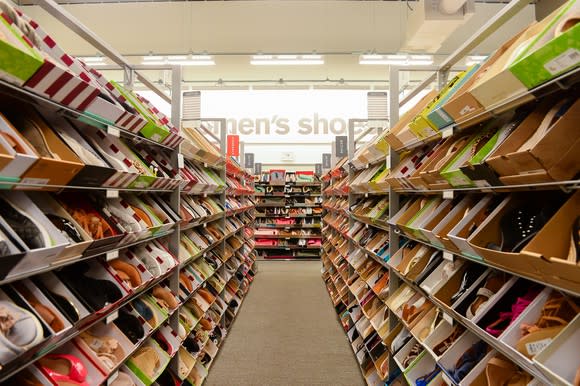Should You Buy Nordstrom at Its 2018 Lows?
Nordstrom's (NYSE: JWN) shares tumbled 11% to a year-to-date low on May 18 after the high-end retailer reported its first quarter earnings. That drop was surprising, since the company beat expectations on the top and bottom lines.
Nordstrom's revenue rose 6% annually to $3.47 billion, beating estimates by $10 million. Its diluted earnings climbed 38% to $0.51 per share, topping expectations by seven cents. Those headline numbers looked solid, so why did the stock tumble?

Image source: Nordstrom.
Why investors were disappointed
Nordstrom's comparable store sales rose just 0.6% during the quarter, missing the consensus estimate for 1% growth. Comps at its full-price stores rose 0.7%, while comps at its off-price Nordstrom Rack stores grew just 0.4%.
The slowdown in Rack's comps was particularly disappointing, since it had traditionally outgrown its pricier namesake brand while supporting Nordstrom's total comps growth:
Q1 2017 | Q2 2017 | Q3 2017 | Q4 2017 | Q1 2018 | |
|---|---|---|---|---|---|
Nordstrom | (2.8%) | 1.4% | (1.2%) | 2.4% | 0.7% |
Nordstrom Rack | 2.3% | 9.8% | 0.8% | 3.7% | 0.4% |
Total | (0.8%) | 1.7% | (0.9%) | 2.6% | 0.6% |
Comparable store sales growth. Source: Nordstrom quarterly reports.
Nordstrom didn't identify any particular headwinds for Nordstrom Rack, but it's likely struggling against rival off-price retailers like TJX Companies' (NYSE: TJX) T.J. Maxx, Marshalls, and HomeGoods, along with Ross Stores and Burlington Stores. Competition from fast fashion retailers like Inditex's Zara and top e-tailers likely exacerbated the pain.
During the conference call, co-president Blake Nordstrom stated that the company was "focused on making improvements" to Rack's business, but didn't disclose many details beyond "a number of initiatives" in women's apparel, plans to "get the mix and the buyer right," and some new store openings.
Nordstrom's store count rose from 353 in the prior year quarter to 373, led by the openings of 16 new Rack stores. Yet those openings, along with expenses related to its new Nordstrom Men's Store in New York, caused its gross margin to dip 21 basis points annually to 34.1%.

Image source: Nordstrom.
They also fueled concerns that Nordstrom was relying too heavily on store openings rather than comps growth to grow its total revenues. On the bottom line, Nordstrom's EBIT rose just 1% annually to $153 million. That accounted for 4.4% of its total sales, compared to 4.6% a year ago.
Nordstrom's guidance for the full year was also soft. It reiterated its guidance for 0.7% to 2% sales growth, compared to the consensus estimate for 3.6% growth. It then trimmed its EBIT guidance to $885-$940 million -- which implies a 4.4% decline to 1.5% growth. Analysts had expected a 2.1% decline.
On the bright side...
Despite those growth concerns, Nordstrom's digital sales still rose 18% annually and accounted for 29% of its sales, compared to 25% a year ago. That growth was a double-edged sword -- it throttled Rack's brick-and-mortar sales, but it indicates that Nordstrom won't be left in the dust by e-tailers. An expanding e-commerce ecosystem gives Nordstrom more freedom to shutter non-performing stores.
Nordstrom also generates higher sales per square foot than most of its rivals. Across all its stores, Nordstrom generated $368 per square foot in sales in 2017. Macy's (NYSE: M) generated just $151 per square foot last year, while Rack's off-price rivals TJX and Ross raked in $328 and $322 per square foot, respectively.
Nordstrom's stock looks cheap at 13 times this year's earnings, and it pays a hefty forward dividend yield of 3%. That low valuation and high yield should limit its downside potential at these levels.
Should you buy Nordstrom at its 2018 lows?
Nordstrom looks oversold, but there are better retail plays on the market now. Macy's trades at just ten times this year's earnings and pays a forward yield of 5.2% -- and it recently impressed the market with a surprisingly solid first quarter.
TJX is also probably a better "pure play" on off-price retail than Nordstrom, which is trying to get Rack's growth back on track. I'd personally stick with those two stocks instead of buying Nordstrom at these levels.
More From The Motley Fool
Leo Sun has no position in any of the stocks mentioned. The Motley Fool recommends Nordstrom and The TJX Companies. The Motley Fool has a disclosure policy.

 Yahoo Finance
Yahoo Finance 